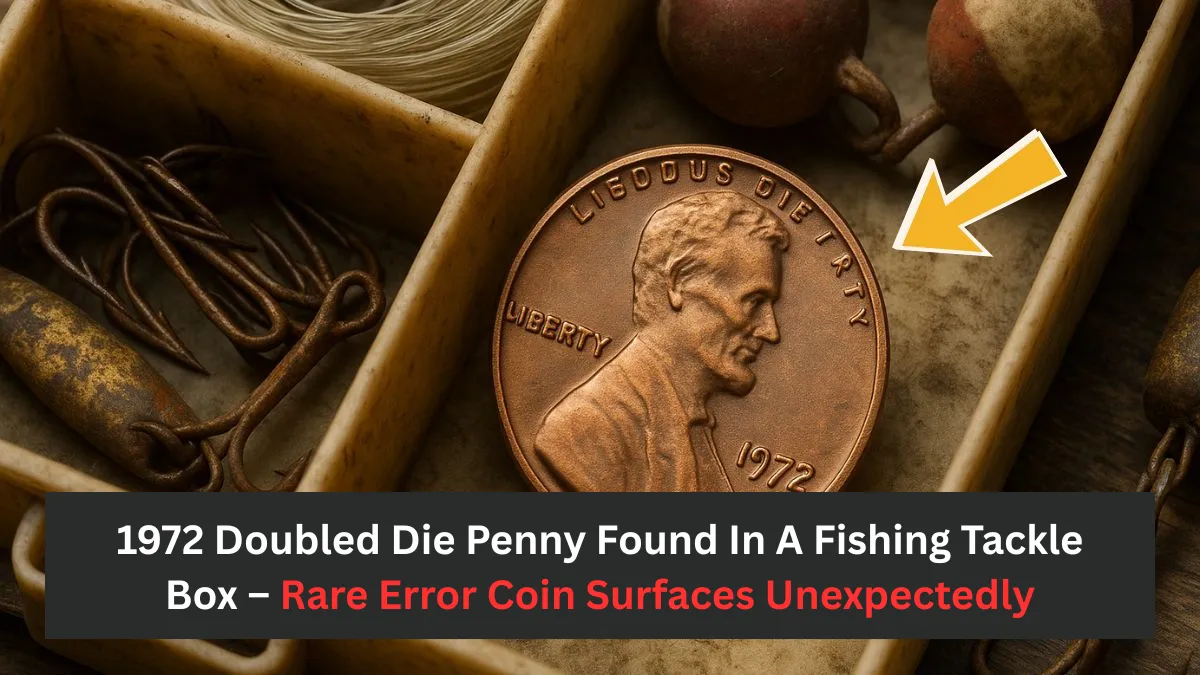Surprising Discovery: 1972 Doubled Die Penny Found in a Fishing Tackle Box
An unexpected treasure was uncovered in an unlikely spot when a 1972 doubled die Lincoln penny surfaced inside an old fishing tackle box. While sorting through fishing gear passed down from a late relative, the owner stumbled upon the coin tucked inside a rusty Altoids tin alongside spare hooks and sinkers.
Typically, coins found in tackle boxes are dismissed as ordinary or junk, but this coin stood out immediately. Its noticeable doubling on the date and lettering attracted the attention of numismatic experts. What started as a simple weekend garage cleanout has now transformed into a potential payday worth five figures, with collectors already showing keen interest.
This penny belongs to a rare mint error category called “Doubled Die Obverse (DDO),” where the coin’s obverse was struck twice with a slight misalignment, causing a visible duplication effect—especially on the date and inscriptions such as “LIBERTY” and “IN GOD WE TRUST.” Within the world of coin collecting, such errors are highly sought after.
What Is a 1972 Doubled Die Penny?
The 1972 doubled die penny is one of the most well-known and coveted error coins among Lincoln cents. Several varieties of doubled dies exist from that year, but the Type 1 variety is the most prized and easiest to identify. This minting mistake happened when the coin die was accidentally struck twice at the U.S. Mint, with a slight offset, producing doubled elements on the coin’s front side.
What distinguishes the Type 1 variety is the bold, unmistakable doubling visible on the date (1972), the word “LIBERTY,” and the phrase “IN GOD WE TRUST.” These errors are quite prominent and can be detected without magnification. Because this error appeared on only a limited number of coins, those that survive in good condition are highly valued. Among collectors, this coin ranks near the top in terms of Lincoln cent rarity.
How Much Is a 1972 Doubled Die Penny Worth?
The value of a 1972 doubled die penny varies greatly based on its condition. Typical circulated examples generally sell for between $300 and $500, but well-preserved specimens can fetch significantly higher prices. Uncirculated coins graded MS-60 or above could bring in $1,000 to $3,000 or more at auction. For example, a Red MS-66 specimen sold for upwards of $14,000 in 2021.
Several factors influence the coin’s worth, including:
- The coin’s overall condition, free from scratches, stains, or wear
- The color of the coin, with Red coins commanding higher prices than Brown or Red-Brown
- Certification and grading by reputable services like PCGS or NGC
- Market demand at the time of sale
If the penny found in the tackle box is well preserved and receives a strong grading, the finder might be looking at a very profitable discovery.
Why Do These Coins End Up in Unexpected Places?
Rare coins often turn up in surprising locations such as junk drawers, toolboxes, or—as in this case—fishing tackle boxes. Sometimes, people put away coins after hearing they might have value but later forget about them. In other cases, a coin may have been kept simply because it looked unusual or different, without anyone realizing its true worth.
The 1972 doubled die penny has been highlighted in collector publications and numismatic guides, but many individuals still do not know how to recognize it.
This example highlights why it’s important to carefully examine any older pennies you find. A quick look at the date and lettering can reveal a valuable numismatic find. This recent discovery serves as a great reminder that valuable error coins might be hiding right under our noses or even tucked away in a fishing tackle box.
Conclusion: A Lucky Catch for the Ages
Finding a 1972 doubled die penny in a fishing tackle box is more than just an interesting story—it underscores the hidden treasures that can be found all around us. Whether it’s passed down through family, stored in a coin jar, or hidden in an attic box, seemingly ordinary items can sometimes hold extraordinary value.
For collectors and casual enthusiasts alike, this story confirms that some of the greatest finds aren’t in the water—they’ve been waiting to be discovered inside the box all along.
FAQs
Q1: How do I know if I have a 1972 doubled die penny?
Look for clear doubling on the date, “LIBERTY,” and “IN GOD WE TRUST.” Type 1 has bold, visible duplication easily seen without a magnifier.
Q2: Are all 1972 pennies valuable?
No, only specific doubled die varieties are worth significant money. Regular 1972 pennies are only worth face value unless in mint condition.
Q3: Should I get my penny graded?
Yes—if you suspect it’s a doubled die variety and it’s in good shape, getting it graded by PCGS or NGC can greatly increase its resale value.
Q4: How many 1972 doubled die pennies were made?
It’s estimated that about 250,000 of the Type 1 doubled die pennies were struck, though far fewer survive in top condition today.
John M. Moody is a passionate writer known for his insightful and engaging storytelling. With a background in astrology and a love for exploring the human experience, John weaves cosmic wisdom into compelling narratives that inspire and enlighten. His work spans articles, essays, and spiritual guides, often blending mystical themes with real-life reflections. When he's not writing, John enjoys stargazing, reading mythology, and connecting with nature for creative inspiration.
